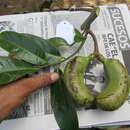zh-TW
在導航的名稱


Cymbopetalum penduliflorum is a species of plant in family Annonaceae. The specific epithet penduliflorum derives from the Latin pendulus (pendent or hanging)[2] and florum (flowered).[3][1]
Common names include "sacred earflower".[4] In Spanish the plant is called flor de la oreja[5] or orejuela, and in Nahuatl it is called xochinacaztli. In the Guatemalan municipality of Todos Santos Cuchumatán it is called tzchiquin itz in the Mam language. It is called muc' by the Qʼeqchiʼ in the area of Cobán.[6]
The plant grows as a tree or small shrub[5] with distichous, subsessile, oblanceolate leaves. It has solitary flowers borne on long slender peduncles coming from the internodes of the smaller branches. Its sepals are broadly ovate or suborbicular, cuspidate, reflexed at length, The outer petals are similar, but are much larger than the sepals. The inner petals are thick and fleshy with an involute margin that causes them to resemble a human ear. When fresh, the pungent flowers are greenish-yellow with the inner surface of the inner petals tending towards orange, at length turning brownish-purple or maroon, breaking with a bright orange fracture.[4]
The dried flowers of C. penduliflorum and related species C. costaricense[7] were traditionally used to give a spicy flavor to chocolate[5] before the arrival of cinnamon and the other Old World spices.[4] The dried petals are still used to in atoles, pinoles, and coffee.[6]
It is native to mountainous areas of southern Mexico, Guatemala,[4][5] and El Salvador.[8] It is still cultivated as a spice in the Guatemalan regions around Cobán and Jacaltenango and sold in markets in those areas as well as Antigua Guatemala, Santa Ana, El Salvador, and San Andrés Tuxtla, Mexico.[6]
Cymbopetalum penduliflorum is a species of plant in family Annonaceae. The specific epithet penduliflorum derives from the Latin pendulus (pendent or hanging) and florum (flowered).
Common names include "sacred earflower". In Spanish the plant is called flor de la oreja or orejuela, and in Nahuatl it is called xochinacaztli. In the Guatemalan municipality of Todos Santos Cuchumatán it is called tzchiquin itz in the Mam language. It is called muc' by the Qʼeqchiʼ in the area of Cobán.
The plant grows as a tree or small shrub with distichous, subsessile, oblanceolate leaves. It has solitary flowers borne on long slender peduncles coming from the internodes of the smaller branches. Its sepals are broadly ovate or suborbicular, cuspidate, reflexed at length, The outer petals are similar, but are much larger than the sepals. The inner petals are thick and fleshy with an involute margin that causes them to resemble a human ear. When fresh, the pungent flowers are greenish-yellow with the inner surface of the inner petals tending towards orange, at length turning brownish-purple or maroon, breaking with a bright orange fracture.
The dried flowers of C. penduliflorum and related species C. costaricense were traditionally used to give a spicy flavor to chocolate before the arrival of cinnamon and the other Old World spices. The dried petals are still used to in atoles, pinoles, and coffee.
It is native to mountainous areas of southern Mexico, Guatemala, and El Salvador. It is still cultivated as a spice in the Guatemalan regions around Cobán and Jacaltenango and sold in markets in those areas as well as Antigua Guatemala, Santa Ana, El Salvador, and San Andrés Tuxtla, Mexico.
Cymbopetalum penduliflorum (Dunal) Baill. – gatunek rośliny z rodziny flaszowcowatych (Annonaceae Juss.). Występuje naturalnie w Meksyku, Belize, Gwatemali oraz Salwadorze[3][4].
Rośnie w w lasach. Występuje na wysokości od 1200 do 1400 m n.p.m.[4]
Cymbopetalum penduliflorum (Dunal) Baill. – gatunek rośliny z rodziny flaszowcowatych (Annonaceae Juss.). Występuje naturalnie w Meksyku, Belize, Gwatemali oraz Salwadorze.
Cymbopetalum penduliflorum là loài thực vật có hoa thuộc họ Na. Loài này được (Dunal) Baill. mô tả khoa học đầu tiên năm 1868.[1]
Cymbopetalum penduliflorum là loài thực vật có hoa thuộc họ Na. Loài này được (Dunal) Baill. mô tả khoa học đầu tiên năm 1868.